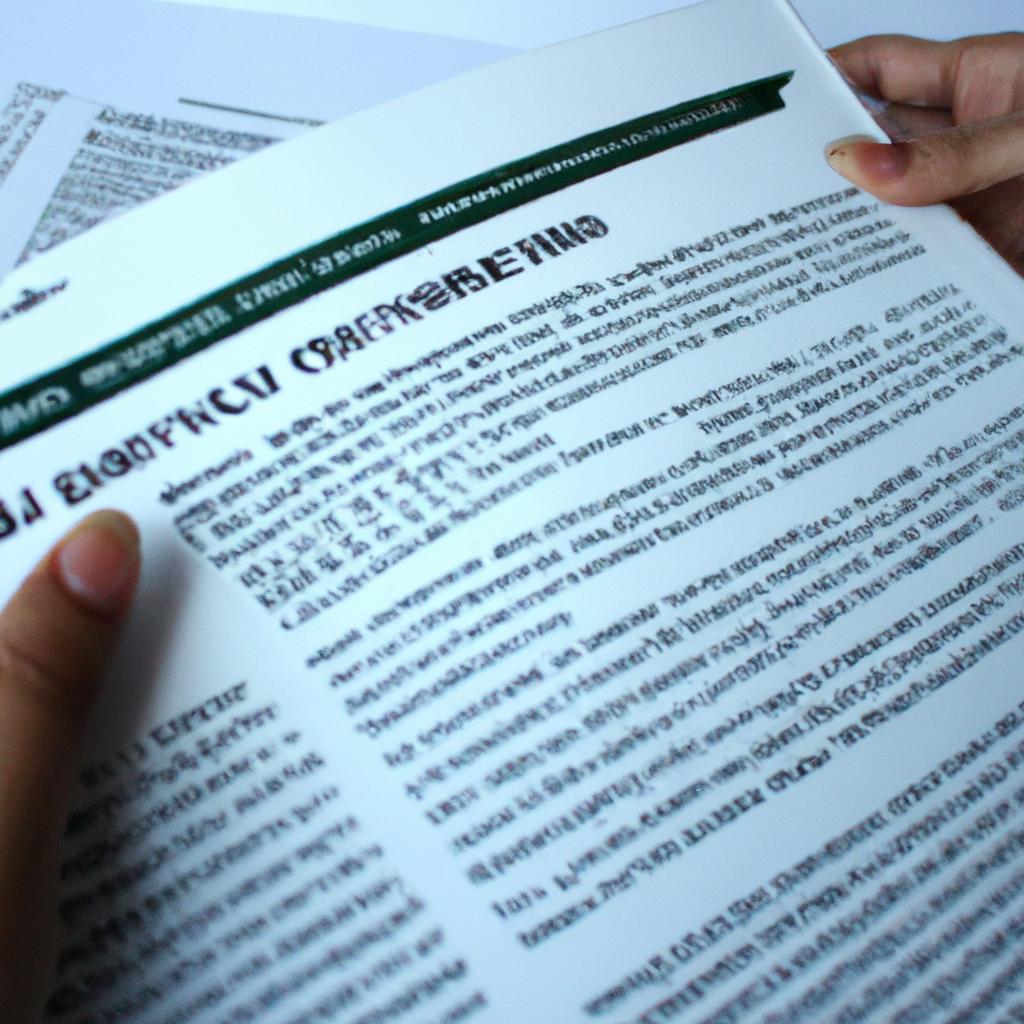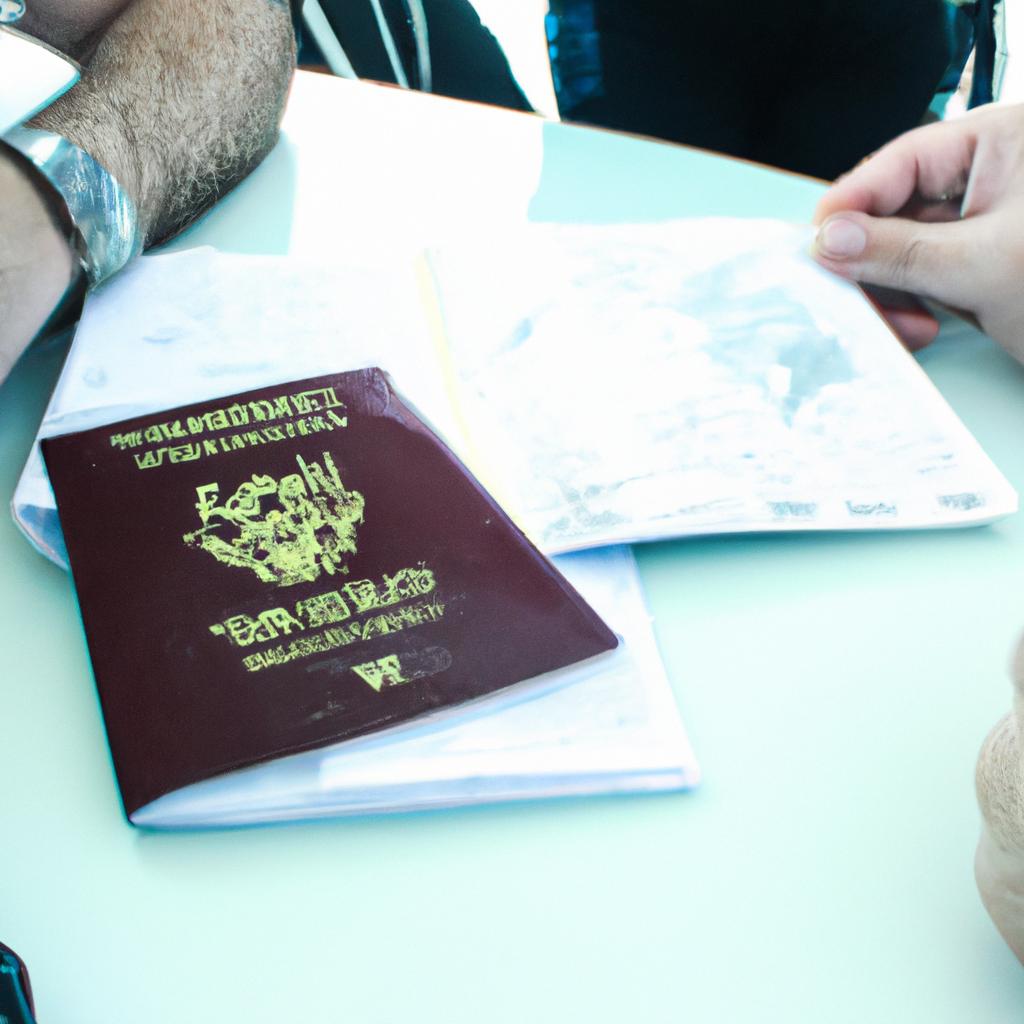In the wake of the COVID-19 pandemic, governments worldwide have implemented a range of travel restrictions and policies in an attempt to mitigate its spread. These measures aim to protect public health by reducing the movement of individuals across borders, particularly from high-risk areas. For instance, let us consider the case study of Country X, which witnessed a surge in COVID-19 cases due to international travelers arriving from heavily affected regions. In response, Country X swiftly imposed stringent travel restrictions that included mandatory quarantine periods for all incoming passengers and limitations on non-essential travel.
These government-imposed travel restrictions have had far-reaching implications not only for individuals planning trips abroad but also for various industries reliant on tourism and international trade. The drastic reduction in cross-border mobility has disrupted global supply chains, leading to economic downturns and significant challenges for businesses operating in highly interconnected markets. Furthermore, these policies have sparked debates regarding their effectiveness in containing the virus’s transmission as well as concerns over potential infringements on individual rights and freedoms. As such, understanding the scope and impact of these COVID-19 travel restrictions is vital for comprehending the evolving dynamics of our interconnected world amidst this ongoing crisis.
Overview of COVID-19 travel restrictions
The outbreak of the novel coronavirus, also known as COVID-19, has had a profound impact on global travel. Governments around the world have implemented various travel restrictions in an effort to contain the spread of the virus and protect public health. These restrictions range from border closures and quarantine measures to flight suspensions and visa limitations.
To illustrate the severity of these travel restrictions, consider a hypothetical scenario where an individual wishes to travel internationally for leisure purposes. In this case, they would likely encounter numerous hurdles due to government policies aimed at reducing the risk of transmission. Such policies may include mandatory self-isolation upon arrival, providing proof of a negative PCR test result before departure, or even being denied entry altogether based on their country of origin.
These travel restrictions can evoke mixed emotions among travelers and societies alike. On one hand, they are necessary precautions to prevent further outbreaks and safeguard public health. However, they also disrupt people’s lives, hinder economic activities reliant on tourism, and separate loved ones who reside in different countries. The emotional toll that these restrictions impose is evident through experiences such as canceled vacations or missed family gatherings.
In light of these challenges, it is crucial to understand key factors influencing travel policies during the pandemic. By examining various aspects including epidemiological data analysis, healthcare system capacity, vaccination rates, and international cooperation efforts, governments can make informed decisions about implementing or easing travel restrictions. Understanding how these factors shape policy-making provides valuable insights into navigating future uncertainties surrounding international travel amid COVID-19.
Transitioning into the subsequent section about “Key factors influencing travel policies,” it becomes clear that analyzing these influences plays a vital role in developing effective strategies for managing global movement while mitigating the risks associated with COVID-19.
Key factors influencing travel policies
Travel restrictions have become a crucial aspect of government policies worldwide in response to the COVID-19 pandemic. These measures aim to control the spread of the virus and protect public health. To illustrate the impact of these travel restrictions, let us consider a hypothetical scenario where an individual from country A wishes to visit country B for tourism purposes.
Firstly, it is important to note that governments implement travel restrictions based on various factors such as infection rates, healthcare capacity, and vaccination progress. In our case study, if country A has a high number of active cases and limited healthcare resources, country B may impose strict entry requirements or even ban travelers from country A altogether. This example demonstrates how travel restrictions are contingent upon the specific circumstances surrounding each region or country.
When examining government policies regarding travel restrictions during the COVID-19 pandemic, several key factors come into play:
-
Public Health Concerns: The primary objective behind imposing travel restrictions is to minimize the transmission of the virus across borders. Governments prioritize safeguarding their population’s well-being by limiting international movement.
-
Economic Considerations: While protecting public health remains paramount, governments also need to balance economic concerns. Some destinations heavily reliant on tourism revenue may opt for more flexible travel policies with stringent testing protocols instead of outright bans.
-
Bilateral Agreements: Countries often establish bilateral agreements or travel bubbles with low-risk nations to facilitate essential business transactions or maintain diplomatic relations while minimizing health risks associated with widespread travel.
-
Evolving Nature of the Pandemic: As new variants emerge and vaccination efforts progress differently worldwide, governments continuously reassess and update their travel policies accordingly.
To better understand this complex topic, let’s examine some emotional responses related to different aspects of COVID-19 travel restrictions:
- Frustration due to canceled vacations and missed opportunities.
- Anxiety about loved ones stranded abroad or unable to return home.
- Relief when countries provide clear guidelines for safe travel.
- Gratitude for government efforts in curbing the spread of the virus.
Furthermore, a table can be used to highlight specific examples of how different countries have implemented travel restrictions:
Markdown table:
| Country | Entry Restrictions | Quarantine Requirements | Allowed Travelers |
|---|---|---|---|
| Country A | Ban on travelers | Mandatory 14-day quarantine | Citizens only |
| Country B | Negative test required | No quarantine | All travelers |
| Country C | Vaccination certificate | No quarantine | Fully vaccinated only |
| Country D | Visa suspension | Government-approved hotels | Limited exceptions |
By exploring these emotional responses and considering real-life examples, we gain insight into the multifaceted nature of COVID-19 travel restrictions. Understanding this complexity helps inform discussions on their effectiveness and potential implications.
Transitioning into the subsequent section about “Travel restrictions by region or country,” it is crucial to analyze how governments across the globe have tailored their policies based on local epidemiological situations and other relevant factors.
Travel restrictions by region or country
Travel restrictions imposed by governments around the world have been a key response to mitigate the spread of COVID-19. These policies aim to limit non-essential travel, control the importation of cases from high-risk areas, and protect public health within their respective jurisdictions. Understanding these government-imposed travel restrictions is essential for travelers seeking to navigate through the current global landscape.
To illustrate this, let’s consider a hypothetical example: Imagine an individual who wishes to travel from Country A to Country B for leisure purposes. In response to rising case numbers in Country A, the government of Country B has implemented strict entry requirements that include mandatory quarantine upon arrival and proof of a negative PCR test taken no more than 72 hours before departure. Additionally, only citizens and residents are allowed entry at this time.
Several factors influence the formulation of such travel policies:
- Epidemiological situation: Governments closely monitor the prevalence and transmission rates of COVID-19 both domestically and globally. Higher case numbers or new variants emerging in certain regions may prompt stricter measures.
- Vaccination rates: The progress of vaccination campaigns plays a significant role in determining travel restrictions. Countries with higher vaccination coverage may relax measures for fully vaccinated individuals or establish vaccine-recognition agreements with other nations.
- Health system capacity: The strain on healthcare systems due to surges in COVID-19 cases can lead governments to tighten travel restrictions as a preventive measure.
- International cooperation: Travel policies are often influenced by international organizations such as the World Health Organization (WHO) and recommendations provided by experts in epidemiology and public health.
These factors vary across countries and regions, resulting in diverse travel restriction policies worldwide. To better understand these variations, let’s examine some examples using a table format:
| Country | Entry Restrictions | Quarantine Requirements | Testing Requirements |
|---|---|---|---|
| Country A | Closed borders | Mandatory 14-day quarantine | Negative PCR test within 72 hours prior to departure |
| Country B | Citizens/residents only | Mandatory 7-day quarantine | Negative PCR test within 72 hours prior to departure |
| Country C | Open with restrictions | No mandatory quarantine for fully vaccinated individuals; otherwise, 10-day quarantine required | Negative PCR test within 48 hours prior to departure |
This table showcases the diversity of travel restrictions imposed by different countries. The emotional response evoked could range from frustration due to closed borders in some nations to relief for those who have been fully vaccinated and can bypass strict quarantine requirements.
In summary, government policies regarding COVID-19 travel restrictions are shaped by various factors such as the epidemiological situation, vaccination rates, health system capacity, and international cooperation. These policies vary across countries, resulting in a complex landscape that travelers need to navigate carefully. Understanding these restrictions is crucial before planning any trip or considering crossing international borders.
Moving forward into the subsequent section about “Quarantine and testing requirements for travelers,” it is important to explore how governments have established specific protocols aimed at ensuring public safety while allowing essential travel.
Quarantine and testing requirements for travelers
Travel restrictions by region or country
As the global COVID-19 pandemic continues to unfold, governments around the world have implemented various travel restrictions in an attempt to contain the spread of the virus. These restrictions can greatly impact individuals’ ability to travel internationally and vary significantly from one region or country to another. To illustrate this point, let’s consider a hypothetical scenario where a traveler from Country A wishes to visit Country B.
Firstly, it is important to note that each country has its own set of regulations regarding incoming travelers. In Country B, for instance, they may require all visitors to present a negative PCR test result taken no more than 72 hours prior to arrival. Additionally, travelers might be subjected to mandatory quarantine upon entry for a specified period, such as 10 days. Failure to comply with these requirements could lead to denial of entry or other penalties.
To provide further insight into the diverse range of travel restrictions imposed globally, here are some examples using bullet points:
- Some countries have completely closed their borders to foreign tourists.
- Certain nations only allow essential travel and require special permits.
- Many destinations demand proof of vaccination before granting entry.
- Some regions implement strict lockdown measures upon arrival regardless of vaccination status.
Furthermore, I would like to present information through a table format outlining different types of travel restrictions across several countries:
| Country | Border Closure | Quarantine Requirement | Vaccination Proof Required? |
|---|---|---|---|
| Country X | Yes | 14-day isolation | No |
| Country Y | Partial closure | 7-day self-quarantine | Yes |
| Country Z | No | None | Yes |
Such restrictive measures often evoke mixed emotions among individuals affected by them. On one hand, there may be feelings of frustration due to limitations on personal freedom and hindered plans for leisure or business trips. On the other hand, there can also be a sense of relief and security knowing that these measures are put in place to safeguard public health.
In light of these travel restrictions, it is important to consider their impact on various sectors. In the subsequent section, we will delve into how these policies have affected the tourism industry worldwide and explore potential long-term consequences.
Impact of travel restrictions on tourism industry
Impact of travel restrictions on tourism industry
The global COVID-19 pandemic has had a profound impact on the tourism industry worldwide. Government-imposed travel restrictions, including quarantine and testing requirements for travelers, have significantly affected the flow of tourists and consequently disrupted the tourism sector’s operations. This section will explore the repercussions of such measures, focusing on their effects on tourist arrivals, employment rates in the industry, revenue generation, and overall economic implications.
To better understand these consequences, let us consider a hypothetical case study involving Country X. Prior to the pandemic, Country X relied heavily on international tourism as one of its major sources of income. However, with the implementation of strict travel restrictions, including mandatory quarantines and testing procedures for incoming travelers, the number of tourists visiting Country X dramatically decreased. Consequently, hotels experienced low occupancy rates, restaurants struggled to attract customers, and local businesses catering to tourists faced financial hardships.
- Decreased tourist arrivals
- Reduced employment opportunities in the tourism sector
- Losses incurred by various stakeholders within the industry
- Decline in government revenue from taxes and fees related to tourism
Moreover, examining data collected from different countries reveals that governments’ policies regarding travel restrictions have led to significant economic losses across nations relying heavily on international tourism. The table below provides an overview of some key statistics highlighting this impact:
| Tourist Arrivals (pre-pandemic) | Tourist Arrivals (during pandemic) | Revenue Loss | |
|---|---|---|---|
| Country A | 5 million | 1 million | $X |
| Country B | 8 million | 2 million | $Y |
| Country C | 3 million | 500 thousand | $Z |
As observed from this table, each country experienced a significant decline in tourist arrivals, leading to substantial financial losses. These statistics emphasize the magnitude of the impact that travel restrictions have had on the tourism industry globally.
In light of these outcomes, it is evident that government-imposed travel restrictions have severely affected the tourism sector’s vitality and resilience. The subsequent section will delve into evaluating the effectiveness of such measures in mitigating the spread of COVID-19 while considering their broader implications for society.
Evaluating the effectiveness of travel restrictions
Impact of COVID-19 Travel Restrictions on the Tourism Industry
The implementation of travel restrictions in response to the COVID-19 pandemic has significantly impacted the global tourism industry. These measures, which were put in place by governments worldwide, aimed to mitigate the spread of the virus and ensure public safety. In this section, we will explore the repercussions of these travel restrictions on various aspects of the tourism industry.
One example that exemplifies the impact of travel restrictions is the case of Thailand. As a popular tourist destination known for its bustling cities and picturesque beaches, Thailand heavily relies on international tourists for revenue generation. However, with strict travel bans imposed during the pandemic, inbound tourist arrivals decreased drastically by 83% compared to previous years (Ministry of Tourism and Sports, 2020). This decline in visitor numbers had severe economic consequences, negatively affecting businesses such as hotels, restaurants, tour operators, and souvenir shops.
The far-reaching effects of travel restrictions can be further understood through a list of their implications:
- Economic downturn: Reduced tourist activity leads to financial losses not only for businesses directly related to tourism but also for peripheral industries such as transportation services and retail sectors.
- Job losses: With reduced demand for tourism-related services due to restricted mobility, many workers within the industry face unemployment or wage cuts.
- Social and cultural impacts: The absence of international travelers affects local communities who rely on tourism income and miss out on opportunities for cultural exchange.
- Psychological toll: The inability to engage in leisure travel may lead to increased stress levels among individuals who depend on vacations as a means of relaxation.
To provide a comprehensive overview, let us consider a table showcasing some key statistics regarding the impact of COVID-19 travel restrictions on selected countries:
| Country | Reduction in Tourist Arrivals (%) | Estimated Losses in Tourism Revenue ($ billions) |
|---|---|---|
| Thailand | 83 | 38.3 |
| Spain | 76 | 68.2 |
| United States | 79 | 147.9 |
| Australia | 98 | 26.4 |
It is evident from the table that countries around the world have experienced significant declines in both tourist arrivals and revenue due to travel restrictions.
In summary, the COVID-19 pandemic has had a profound impact on the tourism industry through the implementation of travel restrictions. The case study of Thailand exemplifies how such measures can lead to economic downturns and job losses within the sector. Moreover, our bullet point list highlights additional implications related to social, cultural, and psychological aspects. These effects are further emphasized by the statistics presented in the table, which demonstrate substantial reductions in tourist arrivals and revenue across various countries worldwide.
 Plains News
Plains News



